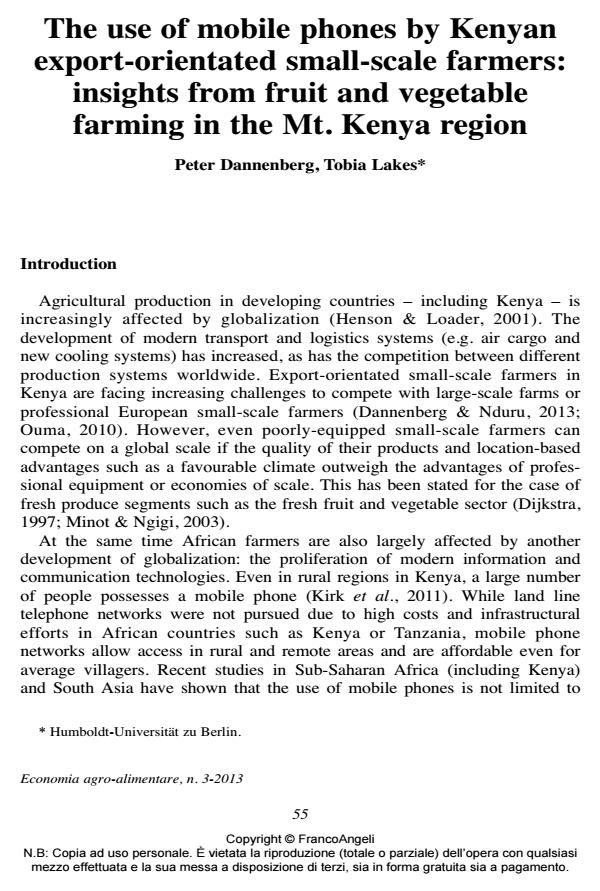The use of mobile phones by Kenyan export-orientated small-scale farmers: insights from fruit and vegetable farming in the Mt. Kenya region
Journal title ECONOMIA AGRO-ALIMENTARE
Author/s Peter Dannenberg, Tobia Lakes
Publishing Year 2014 Issue 2013/3
Language English Pages 21 P. 55-75 File size 544 KB
DOI 10.3280/ECAG2013-003005
DOI is like a bar code for intellectual property: to have more infomation
click here
Below, you can see the article first page
If you want to buy this article in PDF format, you can do it, following the instructions to buy download credits

FrancoAngeli is member of Publishers International Linking Association, Inc (PILA), a not-for-profit association which run the CrossRef service enabling links to and from online scholarly content.
In recent years, mobile phones have become a common feature in business and society in Kenya and are increasingly used in farming. This is also the case for export-orientated small-scale farmers. The aim of this paper is to study the role of mobile phone use by Kenyan export-orientated small-scale fresh fruit and vegetable famers (ffv). We focus on farmers in the Mt. Kenya region using data from questionnaires and expert interviews. We identify four different types of exchange for which mobile phones are used by these farmers: 1. transactions, 2. information, 3. complex knowledge and 4. organization and networking. Our results suggest that the use of mobile phones can improve the farmers’ possibilities for payment, production, marketing, and knowledge transfer, and their competitiveness and integration in international value chains. However, so far the advantages are mostly limited to simple communication and payment; the broad introduction of new applications (with the exception of mobile payment) has not yet taken place.
Keywords: Mobile phones, ict, agriculture, export horticulture, Africa
Jel codes: Q17, F63
- The use of modern information and communication technologies in smallholder agriculture Madlen Krone, Peter Dannenberg, Gilbert Nduru, in Information Development /2016 pp.1503
DOI: 10.1177/0266666915611195 - Decent Work and Economic Growth Michaela Tomchek, pp.1 (ISBN:978-3-319-71058-7)
- Digital (Eco) Systems and Societal Challenges Chiara Cagnetti, Alessio Maria Braccini, pp.11 (ISBN:978-3-031-75585-9)
- Analysing the effects of information and communication technologies (ICTs) on the integration of East African farmers in a value chain context Madlen Krone, Peter Dannenberg, in Zeitschrift für Wirtschaftsgeographie /2018 pp.65
DOI: 10.1515/zfw-2017-0029 - Information and communication technologies (ICT) towards agricultural development in rural areas: case of smallholder farmers in Umzimvubu local municipality of the Eastern Cape Province in South Africa Z Makaula, in South African Journal of Agricultural Extension (SAJAE) /2021 pp.81
DOI: 10.17159/2413-3221/2021/v49n1a10779 - Decent Work and Economic Growth Michaela Tomchek, pp.1024 (ISBN:978-3-319-95866-8)
Peter Dannenberg, Tobia Lakes, The use of mobile phones by Kenyan export-orientated small-scale farmers: insights from fruit and vegetable farming in the Mt. Kenya region in "ECONOMIA AGRO-ALIMENTARE" 3/2013, pp 55-75, DOI: 10.3280/ECAG2013-003005